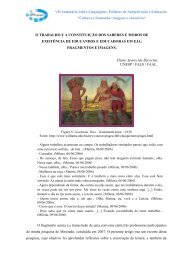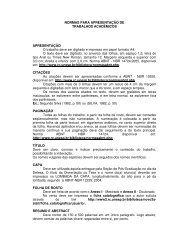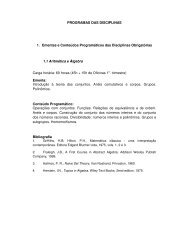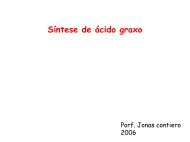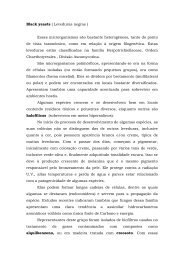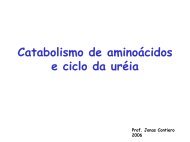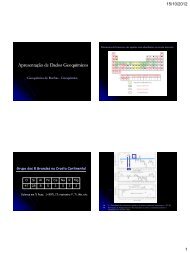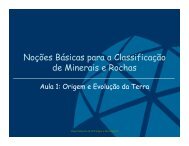Diet and Spatial Pattern of Foraging in Ectatomma opaciventre ...
Diet and Spatial Pattern of Foraging in Ectatomma opaciventre ...
Diet and Spatial Pattern of Foraging in Ectatomma opaciventre ...
You also want an ePaper? Increase the reach of your titles
YUMPU automatically turns print PDFs into web optimized ePapers that Google loves.
608 Sociobiology Vol. 58, No. 3, 2011<br />
<strong>in</strong>fluenced. There is also a relation between <strong>in</strong>dividual <strong>and</strong> collective search<br />
patterns, s<strong>in</strong>ce the forager may <strong>in</strong>fluence the search patterns <strong>of</strong> a nestmate<br />
through communication. Therefore, the distribution <strong>of</strong> resources <strong>in</strong> space<br />
<strong>and</strong> time should be the ma<strong>in</strong> <strong>in</strong>fluences upon the organization <strong>of</strong> search<br />
(Traniello 1989).<br />
There is a tendency for ant species with small colonies to forage <strong>in</strong>dividually<br />
<strong>and</strong> not to present complex recruitment systems, because <strong>in</strong>dividuals <strong>in</strong>teract<br />
directly with few foragers. On the other h<strong>and</strong>, colonies with a lot <strong>of</strong> <strong>in</strong>dividuals<br />
rely on long-term chemical communication between the <strong>in</strong>dividuals, allow<strong>in</strong>g<br />
for rapid recruitment <strong>of</strong> numerous foragers. Between these extremes, there<br />
are <strong>in</strong>termediate behaviors such as t<strong>and</strong>em runn<strong>in</strong>g, group recruitment, <strong>and</strong><br />
mass recruitment (Beckers et al. 1989). In Ectatomm<strong>in</strong>ae, foragers may use<br />
a wide variety <strong>of</strong> strategies to obta<strong>in</strong> food. The forag<strong>in</strong>g methods may vary<br />
from hunt<strong>in</strong>g <strong>in</strong>dependently, with no cooperation dur<strong>in</strong>g food search <strong>and</strong><br />
collection, to various degrees <strong>of</strong> cooperation, with different levels <strong>of</strong> communication<br />
<strong>and</strong> recruitment between nestmates. However, a wide range <strong>of</strong><br />
feed<strong>in</strong>g habits can be observed from species to species, <strong>in</strong>clud<strong>in</strong>g the collection<br />
<strong>of</strong> seeds, fruits, liv<strong>in</strong>g prey, <strong>and</strong> <strong>in</strong>sect secretions (Hölldobler & Wilson<br />
1990; Medeiros & Oliveira 2009).<br />
Among the ants <strong>of</strong> the genus <strong>Ectatomma</strong>, endemic to South <strong>and</strong> Central<br />
America (Brown-Jr 1958; Bolton 1995), several forag<strong>in</strong>g strategies may occur,<br />
such as ambush predation, solitary hunt<strong>in</strong>g, cooperative <strong>and</strong> group hunt<strong>in</strong>g,<br />
<strong>and</strong> even cleptobiosis (Perfecto & V<strong>and</strong>er Meer 1993; Schatz & Wcislo 1999).<br />
As their colonies are small, forag<strong>in</strong>g is more <strong>of</strong>ten solitary (Hölldobler &<br />
Wilson 1990). With a large, functional st<strong>in</strong>g <strong>and</strong> well-developed m<strong>and</strong>ibles,<br />
they are capable <strong>of</strong> subjugat<strong>in</strong>g large, aggressive prey, a characteristic typical<br />
<strong>of</strong> essentially predator species (Hölldobler & Wilson 1990; Wheeler 1986;<br />
Giannotti & Machado 1992; Fernández 1991; Oliveira & Br<strong>and</strong>ão 1991;<br />
Del-Claro & Oliveira 1999; Pie 2004). Regarded as a generalist predator,<br />
<strong>Ectatomma</strong> <strong>opaciventre</strong> uses the hypogeal stratum for nest<strong>in</strong>g <strong>and</strong> the epigeal<br />
for forag<strong>in</strong>g a wide variety <strong>of</strong> arthropods <strong>and</strong> annelids, liv<strong>in</strong>g or recently dead<br />
(Fernández 1991; Pie 2004).<br />
The objective <strong>of</strong> this research was to determ<strong>in</strong>e <strong>in</strong>dividual forag<strong>in</strong>g pathways<br />
<strong>of</strong> workers <strong>of</strong> E. <strong>opaciventre</strong> <strong>and</strong> identify prey types <strong>in</strong> the diet <strong>of</strong> this<br />
species <strong>in</strong> an anthropic area.




